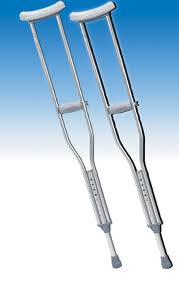Crutches

A Crutch is an assistive device utilized to mitigate mobility impairments or
injuries that hinder walking ability.
Various types of crutches include:
Forearm
Forearm crutches, also known as Lofstrand crutches, feature a cuff at the
top designed to encircle the forearm. They have traditionally been the
prevalent type in Europe, while in the United States and Canada, they were
primarily used by individuals with permanent disabilities.
However, American orthopaedic surgeons are increasingly recommending forearm
crutches for patients with shorter-term needs. To use forearm crutches, the
arm is inserted into the cuff, and the grip is held. The cuff, typically
crafted from plastic or metal, may have a half-circle or full-circle design
with a V-shaped opening in the front to allow the forearm to slip out in the
event of a fall.
Underarm
Underarm crutches are commonly used in Malaysia by individuals with
temporary disabilities or injuries. These crutches involve placing pads
against the ribcage beneath the armpits and gripping the handle, which is
situated below and parallel to the pad. They are sometimes referred to as
axillary crutches.
Strutters
A variation of underarm crutches, strutters incorporate large soles that
remain flat on the floor or ground while the user walks. They promote an
improved walking gait and distribute body weight to reduce the risk of nerve
damage associated with underarm crutches.
Platform
Less prevalent, platform crutches are employed by individuals with poor hand
grip due to conditions such as arthritis or cerebral palsy. The arm rests on
a horizontal platform and is secured in place. The hand rests on a grip that
can be angled accordingly based on the user's disability.
Leg Support
These unconventional crutches are beneficial for users with an injury or
disability affecting one lower leg only. They involve strapping the affected
leg into a support frame that elevates the lower leg from the ground while
transferring the load to the user's knee or thigh. This design allows
walking without utilizing the hands or arms and helps prevent upper thigh
atrophy because the affected leg remains in use.
Walking sticks or canes serve a similar purpose to crutches but are handheld
and have limited load-bearing capability.
Users can adopt various gait patterns depending on the reason for using
crutches. For instance, individuals with a non-weight-bearing injury often
utilize a "swing-to" gait, lifting the affected leg and placing both
crutches in front before swinging the uninjured leg forward.
With underarm crutches, using a towel or soft cover may be necessary to
prevent or minimize underarm injury. Pressure on nerves in the armpit, or
axilla, can lead to a condition known as crutch paralysis or crutch palsy,
which can damage the brachial plexus and nerves like the radial and ulnar
nerves.
For individuals unable to use or preferring not to use crutches,
alternatives such as knee scooters or wheelchairs are available, although
they may present limitations, especially when navigating stairs.
undo Medical Equipment